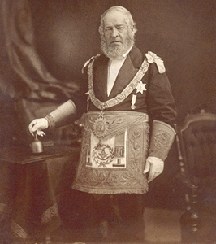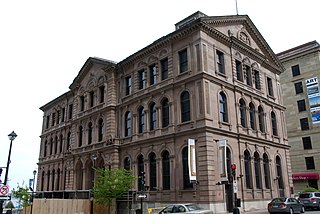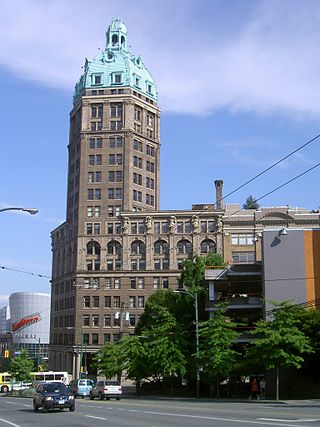Related Research Articles

Andrew Randall Cobb, ARCA, FRIBA was a Canadian-American architect based in Nova Scotia.

Joseph Howe was a Nova Scotian journalist, politician, public servant, and poet. Howe is often ranked as one of Nova Scotia's most admired politicians and his considerable skills as a journalist and writer have made him a provincial legend.

Alexander Keith was the founder of Alexander Keith's Brewery, a businessman, politician and Freemason.

Province House in Halifax is where the Nova Scotia legislative assembly, known officially as the Nova Scotia House of Assembly, has met every year since 1819, making it the longest serving legislative building in Canada. The building is Canada's oldest house of government. Standing three storeys tall, the structure is considered one of the finest examples of Palladian architecture in North America.

The Halifax Public Gardens are Victorian-era public gardens formally established in 1867, the year of Canadian Confederation. The gardens are located in the Halifax, Nova Scotia on the Halifax Peninsula near the popular shopping district of Spring Garden Road and opposite Victoria Park. The gardens were designated a National Historic Site of Canada in 1984.

Hydrostone is a neighbourhood in the North End of the Halifax Peninsula in the Halifax Regional Municipality, Nova Scotia, Canada. It consists of ten short parallel streets and is bordered by Duffus Street to the north, Young Street to the south, Isleville Street to the west and Novalea Drive to the east. The Hydrostone District has about 9.3 ha of landmass.

The Art Gallery of Nova Scotia (AGNS) is a public provincial art museum based in Halifax, Nova Scotia, Canada. The art museum's primary building complex is located in downtown Halifax and takes up approximately 6,200 square metres (67,000 sq ft) of space. The museum complex comprises the former Dominion building and two floors of the adjacent Provincial building.

King's-Edgehill School is a Canadian private university-preparatory boarding and day school located in the town of Windsor, Nova Scotia. It is the oldest English independent school in the Commonwealth outside the United Kingdom, founded by United Empire Loyalists as King's Collegiate School in 1788, and granted Royal Charter by King George III in 1802.

Government House of Nova Scotia is the official residence of the lieutenant governor of Nova Scotia, as well as that in Halifax of the Canadian monarch. It stands in the provincial capital at 1451 Barrington Street; unlike other provincial Government Houses in Canada, this gives Nova Scotia's royal residence a prominent urban setting, though it is still surrounded by gardens.

St. Paul's Church is an evangelical Anglican church in downtown Halifax, Nova Scotia, within the Diocese of Nova Scotia and Prince Edward Island of the Anglican Church of Canada. It is located at the south end of the Grand Parade, an open square in downtown Halifax with Halifax City Hall at the northern end.

The Halifax Court House is a historic building in downtown Halifax, Nova Scotia. Its main section was completed in 1863, with the east wing, built in 1930, being the newest portion. The Italian renaissance style building was designed by William Thomas, a Toronto architect who created prominent structures across Canada, and built by George Lang.

Halifax City Hall is the home of municipal government in Halifax, Nova Scotia, Canada. Designed by architect Edward Elliot, and constructed for the City of Halifax between 1887 and 1890, it is one of the oldest and largest public buildings in Nova Scotia. The property was designated a National Historic Site of Canada in 1997.

Richard Bulkeley was an influential administrator in Nova Scotia from 1749 to 1800. Historian Phyllis Blakeley writes that Bulkeley, "assisted 13 governors and lieutenant governors from Cornwallis to Wentworth. In half a century of service he took part in the founding of Halifax, the immigration of New Englanders and loyalists, and the prosperity of the French revolutionary wars." During his lifetime, known for hosting dignitaries and grand parties, he was known as "the Father of the Province." When he died, he was the last surviving settler who arrived with Cornwallis.

William Tuff Whiteway (1856–1940) was a Canadian architect best known for his work in the early 1900s in Vancouver, although he received commissions in various parts of the United States and Canada during his peripatetic career.
William Hay was a Scottish architect who was actively working internationally from 1842 to 1887. A specialist in gothic architecture, he is primarily known for his work on several churches and cathedrals. His most famous structure is the Bermuda Cathedral in Hamilton, Bermuda which he designed in 1885. Construction of the cathedral began in 1886 and was completed seven years after Hay's death in 1905. He also designed some of the oldest buildings and structures in Toronto, Ontario, from 1853–1861, and was responsible for the restoration of St. Giles' Cathedral in Edinburgh from 1872–1884. His career exemplifies how the British Empire of the Victorian Era was united not only by military and political strength but also by professionals who took advantage of opportunities in its wide array of territories.
David Stirling was a Canadian architect of Scottish birth. In 1872 he was made Dominion architect for the federal works in Nova Scotia and in 1880 he became one of the first associate architects of the Royal Canadian Academy of Arts.

St. George's (Anglican) Round Church is a wooden round church in the neo-Classical Palladian style located in Halifax Regional Municipality in Downtown Halifax. Construction on the church began in 1800 thanks in large part to the financial backing of the British royal family. The church’s primary architect remains a mystery, but Prince Edward, Duke of Kent and Strathearn was highly influential & involved in the design process. It is located at the corner of Brunswick and Cornwallis Streets in the North End district. The church was designated a National Historic Site of Canada in 1983 given its associations with the early history of Halifax and its Palladian architecture.

Henry House is a two-and-a-half-storey stone house located on Barrington Street in Halifax, Nova Scotia, Canada. The house is designated a National Historic Site, and is both a Provincially Registered Property and a Municipally Registered Property under the provincial Heritage Property Act.

Halifax Academy building, or Alliance Atlantis Academy, is a Victorian era building located in downtown Halifax, Nova Scotia. It is a registered heritage property.
References
- 1 2 3 Murphy, Brian D (1994). "BUSCH, HENRY FREDERICK". Dictionary of Canadian Biography. Vol. 13. University of Toronto/Université Laval. Retrieved 29 April 2018.
- 1 2 Henry Busch House. Canadian Register of Historic Places . Retrieved 29 April 2018.